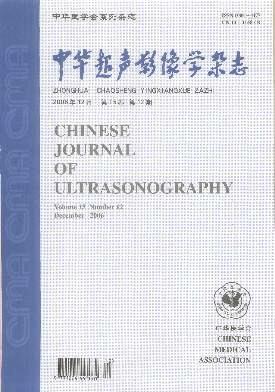Application of vector flow mapping technique in the assessment of left intraventricular pressure gradients in heart failure patients
Q4 Medicine
引用次数: 0
Abstract
Objective To evaluate the changes of intraventricular pressure differences (IVPDs) and intraventricular pressure gradients (IVPGs) in different phases of cardiac cycle in patients with heart failure(HF) patients by relative pressure imaging based on vector flow imaging(VFM). Methods Forty-nine HF patients with left ventricular ejection fraction (LVEF) lower than 0.50 hospitalized in Qilu Hospital of Shandong University from November 2018 to January 2019, including thirty-three patients with HF with reduced ejection fraction (HFrEF group) and fifteen patients with midrange ejection fraction (HFmrEF group), and forty-three controls were enrolled in this study. Clinical data and echocardiographic images were collected and the conventional left ventricular diameter, mass, volume, and systolic and diastolic function parameters were measured. IVPDs and IVPGs during isovolemic systole (IC), rapid ejection (RE), isovolemic diastole (IR), rapid filling (RF) and atrial systole (AC) phases were obtained by the VFM technique. The changes of IVPDs and IVPGs in different phases between the HF and control groups, and their correlations with conventional ultrasound parameters were analyzed. Results IVPDs and IVPGs in heart failure group were significantly reduced compared with the control group especially in isovolumic relaxation phase(all P<0.001). IVPDs and IVPGs showed a decreasing trend in the control group, HFmrEF group and the HFrEF group(P<0.001). IVPDs and IVPGs were correlated with LVID, LVMI, ESV, LVEF, GLS and E/e′ (all P<0.01), among which IVPD-IR and IVPG-IR were best correlated. IVPD-IR and IVPG-IR had excellent diagnostic efficacy for HF patients with LVEF<0.5, with cut-off values of <0.73 mmHg (AUC=0.915, P<0.001) and <0.103 mmHg/cm (AUC=0.932, P<0.001), respectively. Conclusions Early diastolic hemodynamics are severely impaired when systolic function declines.IVPG-IR, as a marker of left ventricular diastolic function, significantly correlates with left ventricular systolic function, and can be used as a potential indicator for assessing left ventricular systolic and diastolic function in patients with heart failure and identifying patients with heart failure. Key words: Vector flow imaging; Relative pressure imaging; Intraventricular pressure gradients; Heart failure向量流成像技术在心衰患者左心室压力梯度评估中的应用
目的应用基于矢量流成像(VFM)的相对压力成像技术,评价心力衰竭(HF)患者不同心循环阶段心室压差(IVPDs)和心室压梯度(IVPGs)的变化。方法选取2018年11月至2019年1月山东大学齐鲁医院住院的49例左室射血分数(LVEF)低于0.50的HF患者,其中射血分数降低的HF患者33例(HFrEF组),射血分数中等的HF患者15例(HFmrEF组),对照组43例。收集临床资料和超声心动图图像,测量常规左室直径、质量、容积、收缩和舒张功能参数。采用VFM技术分别测定等容收缩期(IC)、快速射血期(RE)、等容舒张期(IR)、快速充盈期(RF)和心房收缩期(AC)的ivpd和ivpg。分析HF组与对照组IVPDs、IVPGs在不同时期的变化及其与常规超声参数的相关性。结果心力衰竭组IVPDs和IVPGs较对照组明显降低,尤其是等容松弛期(P<0.001)。对照组、HFmrEF组和HFrEF组ivpd、ivpg均呈下降趋势(P<0.001)。IVPDs、IVPGs与LVID、LVMI、ESV、LVEF、GLS、E/ E′相关(均P<0.01),其中以IVPD-IR和IVPG-IR相关性最好。IVPD-IR和IVPG-IR对LVEF<0.5的HF患者诊断效果极好,临界值分别为<0.73 mmHg (AUC=0.915, P<0.001)和<0.103 mmHg/cm (AUC=0.932, P<0.001)。结论当收缩功能下降时,早期舒张期血流动力学严重受损。IVPG-IR作为左室舒张功能的标志物,与左室收缩功能有显著相关性,可作为评估心衰患者左室收缩和舒张功能、鉴别心衰患者的潜在指标。关键词:矢量流成像;相对压力成像;脑室内压力梯度;心脏衰竭
本文章由计算机程序翻译,如有差异,请以英文原文为准。
求助全文
约1分钟内获得全文
求助全文
来源期刊

中华超声影像学杂志
Medicine-Radiology, Nuclear Medicine and Imaging
CiteScore
0.80
自引率
0.00%
发文量
9126
期刊介绍:
 求助内容:
求助内容: 应助结果提醒方式:
应助结果提醒方式:


